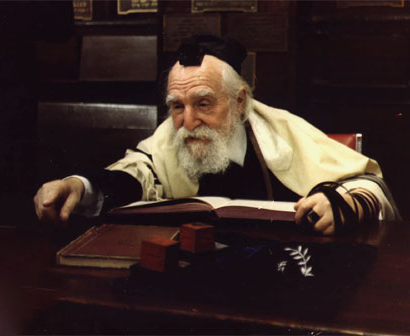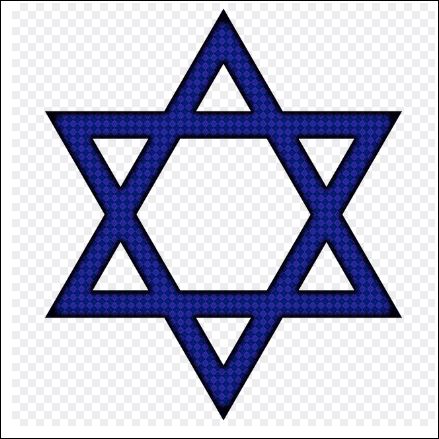 Text 1: Responsa Igrot Moshe (Rabbi Moshe Feinstein)
Text 1: Responsa Igrot Moshe (Rabbi Moshe Feinstein)
Source: Responsa Igrot Moshe, Orach Chaim, Part 3, Siman 15
Topic: Whether there is a halachic concern about removing the shape called Magen David from a Parochet (Ark Curtain)
Date: 2nd Day of Rosh Chodesh Adar, 5729 (1969)
To: My esteemed friend, the great Rabbi, our teacher Rabbi Moshe Cayman, Shlita [May he live long and happily, Amen], Rabbi in Monterrey, Mexico.
Behold, as is known, for hundreds of years they have made the depiction of a Magen David on parochot, mantles [for Torah scrolls], and cloths, and there was no one who contested this. And although we have no [explicit Halakhic] source for the shape of the Magen David, there is no halachic concern regarding it; there is also an aspect to this of reminding that the Holy One, Blessed be He (HaShem Yitbarach – HY”T), is King above, below, and in all four directions. The connection of the name “David” [to this symbol] is not known, but perhaps it is a sign for David, who in his wars trusted in HaShem Yitbarach, who is King above, below, and in all directions, and therefore he did not fear kings of flesh and blood and their armies, as commanded by the Torah.
But in any case, even if it is without a specific reason, I do not see in something that was done this way for hundreds of years – before the Zionist sect existed in the world at all, and when there were no heretics or non-believers in synagogues at all – that there should be any concern of prohibition, nor even of it being an improper act. It is permitted to leave them on the holy vessels, and there is no need to tear them off from there.
And regarding [the fact] that they also wrote the word “Zion” – this is not specifically identified with the Zionist sect. [However,] there is no argument that it is better to remove these letters, because the Magen David shape that was long made on holy vessels was without the word “Zion”. But there is no matter of prohibition in this at all.
And what is written in the book Otzar Dinim U’Minhagim that it is forbidden to make any picture or any image as a sign of faith – there is no source for this, nor any reason to disagree on this with the generations before us who permitted doing this.
And behold I am the friend and esteem the honorable rabbi (Rabbi Moshe Cayman),
Moshe Feinstein
Text 2: Responsa Lehorot Natan (Rabbi Natan Gestetner)
Source: Responsa Lehorot Natan, Part 2, Siman 64
Date: 10th Tammuz, 5734 (1974)
To: Life and peace to the esteemed Rabbi Asher Kitzis, HY”V [Hashem Yichayeihu Viyishmereihu – May Hashem keep him alive and guard him], here in Bnei Brak. Abundant peace and salvation.
Regarding the point raised in the synagogue that shapes of stars are depicted on the eastern wall – I will address this briefly due to lack of time.
A) Indeed, it is explained in the Shulchan Aruch, Yoreh Deah (Siman 141, Se’if 4) that regarding stars, both protruding shapes and sunken shapes are forbidden. However, see the Darkei Moshe (there, small note 5) in the name of a responsum of the Maharam cited in the Mordechai, that even for the shape of the sun and moon, it is permitted if done merely with coloring agents (tziv’onim ba’alma), see there. And this is the answer [found] in Tosafot Yoma (54a), that mere color is neither sunken nor protruding, see there. This is also cited in the Shiltei Gibborim on the Rif, Avodah Zarah (43b). The Pitchei Teshuvah (Siman 141, small note 6) already wondered about the Taz (small note 12 there) and the Nekudot HaKesef for not bringing these words of the Darkei Moshe mentioned above. In our case, where there is only mere color, it is permitted.
B) However, there is still room to doubt based on the unspecified language of other Poskim (Halakhic decisors) who did not write to permit [stars] made of colors. Nevertheless, it can be permitted bedi’avad (post-facto, after the fact) based on what is explained in the Rama (there, Se’if 4) that where many people are present, there is no suspicion (leika chashda) [of idolatry]. And although the Shach writes there (small note 27) in the name of Rabbeinu Yerucham that it is, in any case, a matter which is unseemly, it is explained in the Responsa of my ancestor, the Chatam Sofer (Part 6, Siman 6), that this means one should not do so lechatchila (from the outset), but if it has already been done, one should not change it, see there. And from this is an answer to what is written in the Pitchei Teshuvah there (small note 8), see there.
C) However, regarding the essence of the matter, it appears that these are not shapes of stars at all, but rather the shape with six equal points known as the Magen David. Behold, it is a daily occurrence that these shapes are made, and they are commonly found on parochot and other places. Those who draw shapes of the stars of the heavens do not draw shapes like these, nor do they appear this way to the human eye. In any case, they are not complete images (tzurot gemurot). The Nekudot HaKesef already wrote there regarding the permissibility of the shapes of the twelve Zodiac signs in Machzorim (holiday prayer books) because it is not a complete image, see there. And this is the main reason why I did not protest against doing so. However, regarding what was done in previous years on synagogue ceilings – shapes of Zodiac constellations – my mind is not comfortable with this (ein da’ati nocha), because it seems to me that it was made resembling the arrangement of the stars as they appear in the sky. Nevertheless, since I found it this way, I did not order their removal, based on the reason that when dealing with the public there is no suspicion (of usage for forbidden worship) and according to the words of the Chatam Sofer mentioned above. See also Responsa Chatam Sofer (Orach Chaim, Siman 60).
Signing off with the blessing of the Torah and wishing you all the best, indeed.
Text 3: Alei Tamar (Rabbi Yisachar Tamar) on Yerushalmi Sukkah
Source: Alei Tamar, Tractate Sukkah, Chapter 3, Halacha 8
Topic: Explaining the symbolism and origin of the Magen David
There are several Land of Israel Agadot connected to the original Tiberian Jerusalem Talmud (Yerushalmi). The Damascus version of the Yerushalmi reached the Diaspora only sparsely, as the original Tiberian Yerushalmi existed throughout the Diaspora from ancient times. However, the Ra’avan [Rabbi Eliezer ben Nathan] also had the Damascus version with additions that his grandson, the Rosh [Rabbi Asher ben Yechiel], did not possess. And indeed, although this statement is not in the Yerushalmi before us, Rabbi Yochanan, the great Amora [Talmudic Sage] of the Land of Israel and arranger of the Yerushalmi, said (on page 37 [of Yerushalmi Sukkah]) regarding the shaking [of the Lulav]: “One moves [it] back and forth towards Him to Whom the four directions belong; one raises and lowers [it] towards Him to Whom the heavens and the earth belong.” As the Rosh explains, through the shakings (na’anu’im), one declares the uniqueness (unifies) the Holy One, Blessed be He, in the six extremities – the four directions, heaven, and earth. And with such shaking and such intent, one weakens the power of the Accuser.
And in this, it seems to me, lies the reason that the symbol of the Magen David became widespread throughout the Jewish Diaspora – as a shape of six points composed of two triangles. It is a holy symbol for the nation in the synagogue and on the parochet for the Torah scroll. It seems to me that Israel in their exile used this symbol as a segula to weaken the Satan that accuses. And by virtue of unifying the Holy One, Blessed be He, in the six extremities, Hashem will rebuke the Satan (editor, see: Zechariah 3:2) and the accusation – He Who chooses His nation Israel and Jerusalem.
And they called this “Magen David” (Shield of David), based on his saying countless times [in Psalms]: “But You, Hashem, are a shield (magen) for me” (Ps. 3:4), “You are my hiding place and my shield (magini)” (Ps. 119:114), “You have given me the shield (magen) of Your salvation” (Ps. 18:36), and more. And based on these verses, the blessing after the Haftarah, “Magen David,” was established. This was because he [David] unified the Holy One, Blessed be He, in heaven and earth and the four directions, symbolized by the six points. And this is the Shield of David and the Shield of Israel, in sacred and mundane matters, in every generation. See the book Sefer HaMatamim, entry “Magen David”; and when this symbol was created is not known, but the Rosh already speaks of unifying God in the six extremities to weaken the power of the Accuser.
In summary:
-
Rabbi Feinstein: Finds no prohibition, notes its long-standing use predating Zionism, sees possible symbolism of Hashem’s dominion, and permits its use.
-
Rabbi Gestetner (Lehorot Natan): Argues that even if considered a “star” shape, it’s permitted if only painted; alternatively, permitted post-facto in a public setting. However, his main point is that the Magen David symbol is not depicting an actual star and thus permissible.
-
Rabbi Tamar (Alei Tamar): Connects the six points to the six directions of the Lulav shaking, which declare Hashem’s unity and weaken the Accuser. He suggests this is the spiritual basis for the symbol and its name, rooted in King David’s reliance on Hashem as his “shield.”
